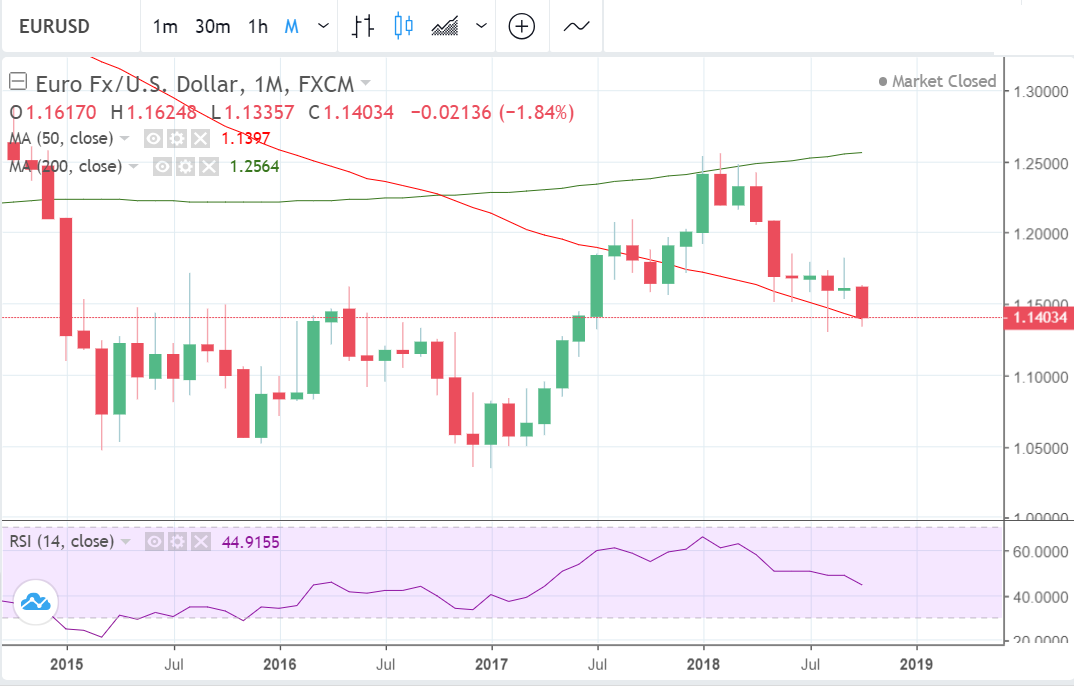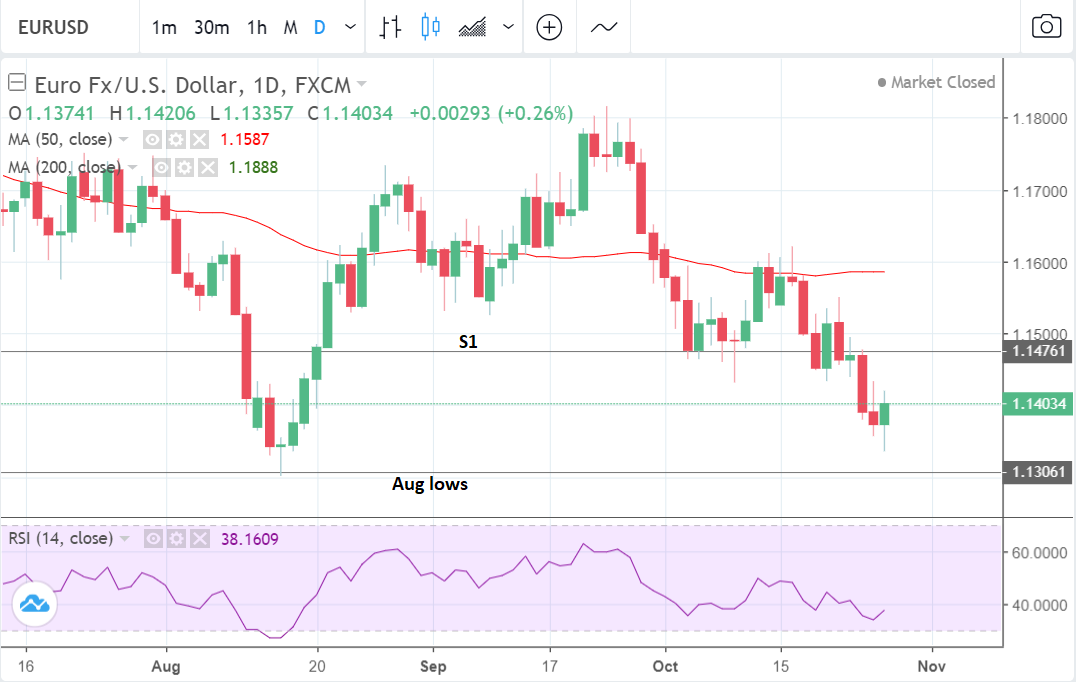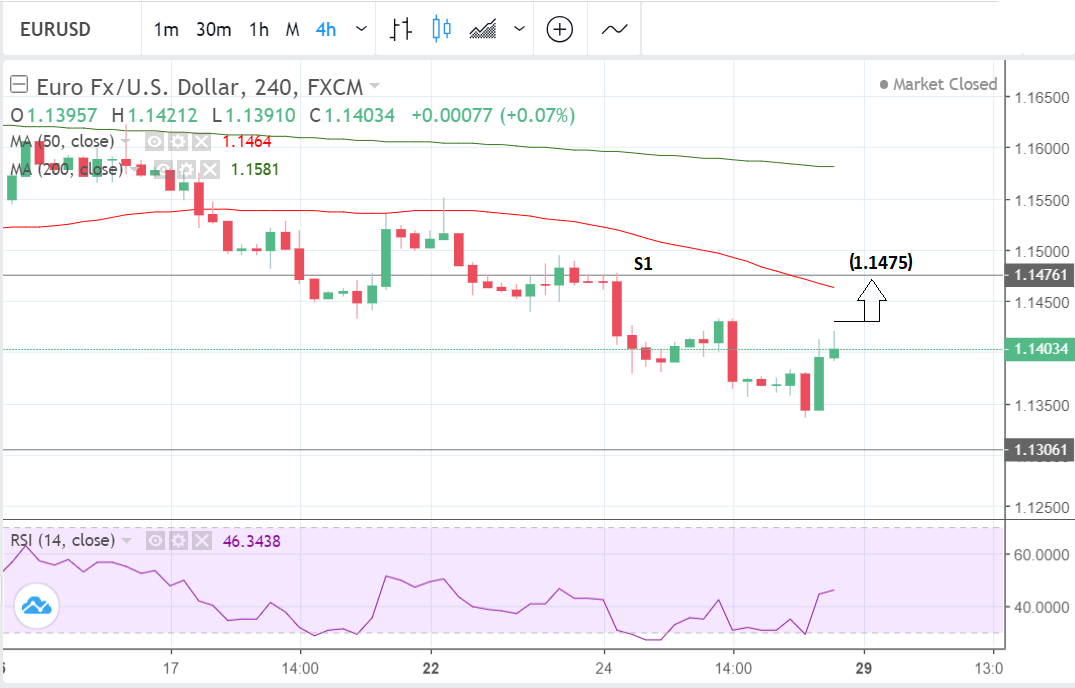The Euro-to-Dollar Rate in the Week Ahead: Bouncing Off the 1.13 Floor

Image © Adobe Images
- EUR/USD could be forming a base above the 12.13 level.
- Market recovered above the 1.14 level after touching its floor.
- EUR eyes GDP and CPI data, payrolls in focus for the USD.
The Euro extended losses last week as a host of factors pushed it lower but the market now looks to have begun carving out a base close to its one-year lows in the 1.13 area.
Italy's budget row with the EU commission and another surprise fall in business confidence both weighed on the market.
EUR/USD almost reached the 1.1301 August and 2018 low last week but just about managed to keep above it and after a last-minute rebound, it closed the week above 1.14.
1.1301 has become something of a Rubicon for the pair so a breach below this level would signal a capitulation and reinforce the downtrend. A hold - as now looks possible - would probably mean the pair has carved out a significant low.
We are bullish given the broader technical picture on the monthly chart. The hammer formed in August remains an intact bullish signpost that could herald a reversal higher. The failed pivot swing in September is also an indicator of recovery.

Above: Euro-to-Dollar shown at monthly intervals.
The market is also underpinned by the 50-month moving average (MA) at 1.1397. This is a large and formidable obstacle to further downside.
The recovery on Friday to close the week back above 1.14 also means the market has closed above that moving average, which also adds a supportive tone to the current market.
We would now want to see a break back below the 1.1336 weekly bottom for confirmation that the 50-month moving average was decisively broken.
The daily chart provides little insight into future direction one way or another but based on the monthly chart we expect the exchange rate to recover.

Above: Euro-to-Dollar rate shown at daily intervals.
The four-hour chart remains too inchoate to signal a change of trend. The short-term trend is down, but because of the higher time frame charts we see a risk of a reversal happening in the coming week.
A break above the 1.1425 level would probably confirm a continuation up to a monthly pivot at 1.1475. Pivots - as the name suggests - are levels where the market often reverse trend so the 1.1475 is a natural target.
However, this is a weak conviction call given the lack of technical corroboration and a challenging fundamental backdrop.

Above: Euro-to-Dollar rate shown at 4-hour intervals.
Advertisement
Bank-beating exchange rates! Get up to 5% more foreign exchange by using a specialist provider to get closer to the real market rate and avoid the gaping spreads charged by your bank when providing currency. Learn more here
The Euro: What to Watch
The main release for the Euro in the week ahead is third quarter GDP and CPI data due at 10:00 am on Tuesday and Thursday respectively.
GDP is expected to have risen at an annualised pace of 1.9% during the third quarter, slower than the 2.1% seen previously. If the actual figure is better than markets expect then the Euro could strengthen.
Inflation is expected to have risen by 2.1% during the October month, unchanged from Septepmber, although the core inflation rate is seen rising 10 basis points to 1%.
Markets will scrutinise the inflation numbers closely for signs that forecasts of a pickup in price pressures, from the European Central Bank, are being borne out.
The Eurozone unemployment rate is another key release in the week ahead. It is expected to have remained at 8.1% in September, although the exact number will not be released until 11.00 on Wednesday.
Advertisement
Bank-beating exchange rates! Get up to 5% more foreign exchange by using a specialist provider to get closer to the real market rate and avoid the gaping spreads charged by your bank when providing currency. Learn more here
The Dollar: What to Watch
The big event for the Dollar in the week ahead is the nonfarm payrolls report due out on Friday at 13:30 London time.
October's payrolls are expected to show the U.S. economy creating 191k new jobs, up from 134k in the previous month.
The relatively weak September figure was put down to the effect of Hurricane Florence preventing people from turning up to work and given this, payrolls are expected to rebound.
"Hurricane Florence was largely to blame for the depressed job growth last month, however, as about 300,000 workers said they were unable to work due to bad weather. This is compared to an average of 85,000 workers in a typical September. Other indicators suggest no signs of a cooling labor market," says Diane Schumaker-Krieg, head of research at Wells Fargo.
The labour report is also forecast to show the unemployment rate rising to 3.8% in October, from 3.7% previously.
Probably as important as the headline payrolls figure will be the average hourly earnings number, which is expected to have risen 3.1% in October, up from 2.8% previously.
Such a rise in wages would be commensurate with an increasingly inflationary outlook, which in turn, would keep the Federal Reserve (Fed) on course to keep raising its interest rate.
Another key release in the week ahead is personal consumption expenditure (PCE), which is a type of inflation gauge, and the preferred measure of the Fed.
Core PCE inflation is expected to rise by 0.1% month-on-month in September from 0% previously. Year-on-year it is expected to rise by 2.0%, the same as in September.
"Continued strength in consumption partly reflects the boost to disposable incomes from tax cuts earlier this year. On Monday, we will receive September personal income and spending data. The strength exhibited in Q3 consumption, however, all but guarantees roughly a 0.3% nominal rise in personal spending for September," says Schumaker-Krieg.
The third major release in the week ahead is the ISM Manufacturing PMI, which is expected to decline to 59.0, from 59.3 previously when it is released on Thursday at 15.00.
The ISM reached a 14-year high in August before moderating in September. Analysts will be watching the data for signs of a continued slowdown that could be attributable to President Donald Trump's tariffs.
"Anecdotal evidence from respondents’ comments highlighted rising input costs and supply constraints attributable to tariffs and labor shortages starting to weigh on activity. We expect the ISM to further moderate to 59.1 in October, as manufacturers continue to face production constraints," says Schumaker-Krieg.
Advertisement
Bank-beating exchange rates! Get up to 5% more foreign exchange by using a specialist provider to get closer to the real market rate and avoid the gaping spreads charged by your bank when providing currency. Learn more here




